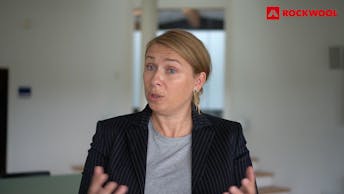A strong foundation for circularity
“We have a good foundation in place already with recycling services for customers in 10 countries and a goal to increase to 30 countries by 2030. Our membership in Circle Economy can help us better understand the opportunities we have in our value chain and help us connect with other stakeholders so the impact can be wider,” says Dorte Vigsø, Sustainability Manager, ROCKWOOL Group.
The ROCKWOOL Group’s business model already incorporates circular economy thinking through the use of upcycled waste materials in production, recycled waste collection schemes in locations around the world, and durable products that are fully recyclable.
In its June report, Circle Economy suggests three key levers for ROCKWOOL to improve its circularity:
• Increase the sourcing of non-virgin and regenerative materials for both raw materials and energy supply.
• Develop more high-value and circular product applications that can be integrated into modular, adaptive building components
• Reclaim more waste from the construction sector through ROCKWOOL’s own recycling service and partnerships with other players.
The report underlines that “the biggest steps towards circularity can only be taken with the support of and collaboration with legislators and value chain partners,” to remove barriers to further recycling of construction waste, for example.
“It’s encouraging that some of what they suggest is to do more of what we are already doing,” says Vigsø. “To move the entire construction industry towards a circular economy model will require more collaboration like this with organisations like Circle Economy and across companies, suppliers and authorities. We look forward to further cooperation and improvements across our industry.”




